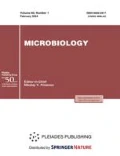Abstract
The influence of chitosan fragments with different degrees of polymerization and some chemical chitosan derivatives on the infectionof Bacillus thuringiensis by phage 1–97 A was studied. It was shown that chitosan inhibits phage infection and inactivates phage particles. The extent of inhibition of phage infection inversely depended on the degree of polymerization of chitosan fragments. On the contrary, the extent of inactivation of phage virulence was proportional to the degree of polymerization. Chitosan derivatives did not inhibit the growth of bacilli. Deaminated chitosan derivatives at a concentration of 100 μg/ml efficiently inhibited phage reproduction, exhibiting no correlation between the degree of deamination and antiviral activity. The anionic derivative chitosan sulfate andN-succinate-6-O-sulfate did not inactivate the phage, did not influence bacterial growth, and did not inhibit the process of viral infection.
Similar content being viewed by others
References
Kochkina, Z.M., Pospieszny, H., and Chirkov, S.N., Chitosan Inhibition of the Phage-induced Lysis ofBacillus thuringiensis, Prikl. Biokhim. Mikrobiol., 1996, vol. 32, no. 2, pp. 249–253.
Kochkina, Z.M. and Chirkov, S.N., Effect of Chitosan Derivatives on the Reproduction of Coliphages T2 and T7,Mikrobiologiya, 2000, vol. 69, no. 2, pp. 257–260.
Kochkina, Z.M., Surgucheva, N.A., and Chirkov, S.N., Inactivation of Coliphages by Chitosan Derivatives,Mikrobiologiya, 2000, vol. 69, no. 2, pp. 261–265.
Chirkov, S.N., Surgucheva, N.A., Gamzazade, A.I., Abdulabekov, I.M., and Pospieszny, H., Relative Efficiency of Chitosan Derivatives in the Inhibition of Viral Infection of Plants,Dokl. Akad. Nauk, 1998, vol. 360, no. 2, pp. 271–273.
Gratia, A., Des relations numeriques entre bacteries lysogenes et particules de bacteriophage,Ann. Inst. Pasteur, 1936, vol. 57, p. 652.
Manual of Methods for General Bacteriology, Gerhardt, P.et al., Eds., Washington: Am. Soc. Microbiol., 1981. Translated under the titleMetody obshchei bakteriologii, Moscow: Mir, 1983, vol. 1.
Naumova, I.B. and Shashkov, A.S., Anionic Polymers of Gram-Positive Cell Walls,Biokhimiya, 1997, vol. 62, no. 8, pp. 947–982.
Lindberg, A.A., Bacteriophage Receptors,Annu. Rev. Microbiol., 1973, vol. 27, pp. 205–241.
Siegel, P.J. and Schaechter, M., The Role of the Host Cell Membrane in the Replication and Morphogenesis of Bacteriophages,Annu. Rev. Microbiol., 1973, vol. 27, pp. 261–282.
Author information
Authors and Affiliations
Rights and permissions
About this article
Cite this article
Kochkina, Z.M., Chirkov, S.N. Influence of chitosan derivatives on the development of phage infection in theBacillus thuringiensis culture. Microbiology 69, 217–219 (2000). https://doi.org/10.1007/BF02756202
Received:
Revised:
Issue Date:
DOI: https://doi.org/10.1007/BF02756202



